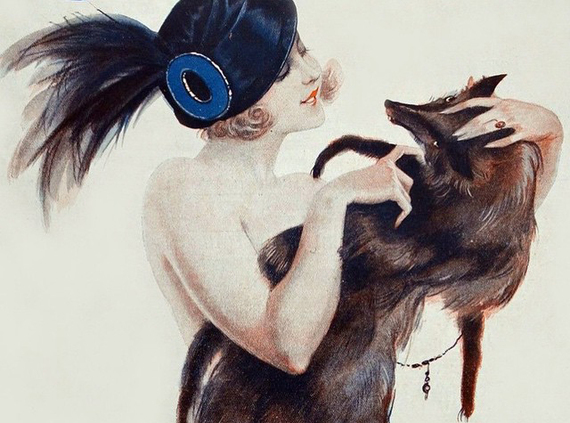NOTE: the content of this post may be sensitive to readers.
It always troubles me to see fellow New Yorkers walking through the cold with their sweater-wrapped canine companions while they, themselves, adorn that ubiquitous coyote fur-trimmed, Canada Goose uniform. The disconnect between the earnest care provided to their dogs, and the callousness imposed upon the closely-related coyotes is especially fascinating and disturbing. Human beings are imperfect and contradictory, but while we stand at the cusp of an age of visionary, high-performance synthetics, why are throngs of wealthy and aspiring urbanites so willing to fatally betray a cousin of the pooches, whom they adore, for a status symbol that has been referred to by the APFBA as the Hummer of outerwear: "Excessive, irresponsible, unnecessary and sooner than many will expect, embarrassing" ?
Jasmine Garnsworthy attempts to answer that very question with a recent article on StyleCaster.com, "I Wear Real Fur -- and I'm Not Ashamed," and that pseudo-rebellious sentiment seems to be shared by a rising number of people. Aside from her mercurial subscription to all things trendy ("fur coats come in all sorts of crazy colors... Fur-based fashion is just so much more fun than it used to be") her article reads like industry talking points, cut and pasted from the marketing website TruthAboutFur.com. And it wouldn't be farfetched if it were.
Back in 2010, the New York Times exposed how the profit-seeking fur biz operates like a lobbyist group representing fur auction houses, farmers and breeders. They solicit students, influencers and young designers by offering incentives like free product or trips to Europe in exchange for doing exactly what Ms. Garnsworthy has done: facilitate the appearance that fur is relevant, a cold-weather necessity, well-regulated and a naughty indulgence. If she hasn't been involved directly with a group like North American Fur Industry Communications (NAFIC), she's clearly missing out on some perks that Instagram sensations like Bryanboy, bloggers like Rumi Neely, and designers like Philip Lim have cashed in on. Garnsworthy is also a bit late to the party, with similar articles on the websites of Elle, The Guardian, The Telegraph and Thought Catalog, which have proven to yield high traffic and intense reader commenting.
Aggressive marketing like the Fur Now campaign, where the International Fur Federation paid the über-cool Surface To Air Studio to make them appear more "Real Hipster than Real Housewife, is not surprising. If the young don't feel the warm embrace of fur, the industry's days are certainly numbered, especially when we consider the next wave of textiles that make things like animal fur obsolete from a design and performance standpoint. We can now grow hair and leather in a lab, or make leather from kombucha or pineapple waste. We can make felt from recycled soda bottles. We can coax bacteria to produce vibrant dyes. We can make polyester and lycra from waste molasses, and bioplastics from methane -- which also means we can make biodegradable, hi-tech, low-impact future-fur and future-leather that is far more customizable and safe than animal skin and hair. Technology is always evolving and becoming more efficient, more refined, more green and more visionary.
Sea Shepherd operates in conditions far worse than New York City. In the wet, frigid, Arctic Ocean, if sustainable hi-tech synthetics and plant-based organics (no feather down or animal fur) are good enough for this crew, it's certainly good enough for winter in your city.
When scientists conceptualize and design clothing for those working in the most fatally cold and wet conditions on planet Earth (think arctic oil rig workers, explorers and ice researchers), one thing they don't include is fur. Instead, firms like Sintec in Norway and their Cold Wear project explore how coats that incorporate electronic systems, nanotechnology and stimuli-responsive polymers will outperform animal skins and hairs by a long-shot. The inefficient task of confining or trapping animals, killing them and chemically preserving their pelts is an affront to good design standards in the 21st century. Advancements in synthetic biology and innovations in bioplastics require that we unlearn our fickle prejudices against the synthetic textiles. Already, the US Army, Marines and Special Forces use Primaloft, a synthetic insulation that, unlike feather down, does not lose its insulating properties when wet. And Primaloft offers its Insulation Gold Eco range, which is made with 90 percent recycled poly.
In this sense, fur is simply bad design. It's stuck in the past, it needs to be slowly grown from the body of an animal, preserved in toxic chemicals and kept cool in the heat so it doesn't decompose or get devoured by insects, as nature intended it to. It requires the inherently cruel, confining or painful trapping of animals and the messiness of actually killing them without damaging the pelts (think about electrified prods inserted into orifices or crushing rib cages and throats). It will never evolve or change. Grace Coddington, Vogue's legendary Creative Director is quietly opposed to the fluff, but Vogue Hommes International editor-in-chief Olivier Lalanne did not mince words about the tactile (and olfactory) lack of luxury associated with fur when he published:
"Fur is as much a no-no as ever. It's sexually dodgy, feels funny and reeks when it's rained on."
I teach fashion at Parsons the New School. I'm also a designer. In one of my classes, Fashion and the Narrative, we talk about the ways in which fashion is used to create characters, identities and stories, but also about the hidden narratives we'd rather not have to consider, like Cambodian sweatshops, child slavery in Uzbekistani cotton fields, genocide in the Brazilian rainforest for cattle grazing, racism on the runway, child labor and toxic waste in Bangladeshi leather tanneries, massive Australian wool shearing operations and even so-called "ethical" North American and European fur farms. The fashion industry overall manages to be globally impactful, yet maintain the perception of being a carefree frivolity -- and that is a dangerous, if not sinister combination. Consider the recent reality show that sent fashion bloggers to work in a sweatshop, about which one cried, "What sort of life is this?"
Perhaps when Tolstoy said, "What a strange illusion it is to suppose that beauty is goodness," he knew it could be applied to fur. That's why we live in a culture where the beauty of fashion objects often stand in harsh contrast to the ugliness of how they're made. And that ugliness is avidly avoided, intentionally hidden beneath layers of expensive marketing, or -- in the case of something like fur, transformed into a transgressive indulgence. The marketed fantasies of fur are never, in reality, what they seem, and those making billions from the body parts of animals, must combat any and every attempt to validate the animal's experience.
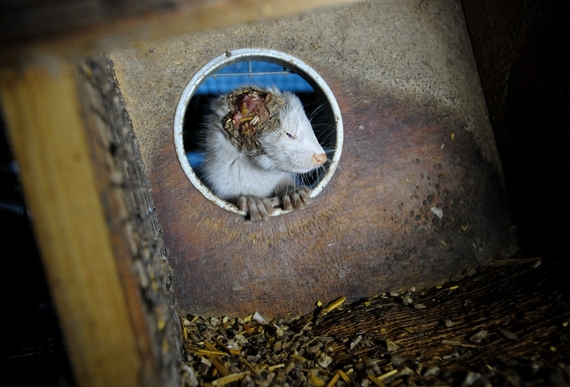
Photo: Jo-Anne McArthur, weanimals.org Close confinement leads to stress and cannibalism. Fighting leads to extreme injury, usually around the mink's faces.
That's why Ms. Garnsworthy uses the term "euthanize" to describe how animals killed for fur have their lives ended. Only in her fantasy, the animals killed for the "kitschy-cute fluffy tufts" she refers to, are gently put-down like we would our beloved, but suffering and terminally ill, cats and dogs. She is fickle with her affections, admitting to be anti-fur when it was on trend, and now pro-fur when there are so many bright colors to choose from and when a fur lobbyist tells her that animals aren't treated so badly. She claims, matter-of-factly that, "[I]f you know the slightest bit about cattle or poultry farming, you'll know [fur] industries are actually governed by similar legislation that protects animal welfare." Yet what she clearly doesn't know is that, according to the Animal Legal Defense Fund, there are no federal laws at all governing the conditions in which farmed animals are raised in the United States -- that includes fur farms. Farmed animals are excluded from most animal welfare regulations. In places like Canada, home of Canada Goose, it is still legal to sell cat and dog fur. You can see a jaw-dropping, point-by-point takedown of Canada Goose's whitewashed and greenwashed fur "policy" at the Association for the Protection of Fur-Bearing Animals' website, one of Canada's most established animal protection groups. In Europe, where many countries have or will soon phase out fur farming, welfare guidelines are vague and often left open to interpretation. They suggest taking "reasonable steps" to prevent "unnecessary pain, suffering or injury", but who determines what steps are reasonable and what injuries or sufferings are necessary? So maybe it's Garnsworthy who doesn't know the slightest bit about animal farming.
She poses the question: "Why would a meat-eating gal who already wears leather need to feel especially guilty about wearing fur as long as it's ethically sourced?" There's a myth that "humane" fur farms exist, that it's possible to get "ethically sourced", "responsible" fur, and that regulations protect animals on fur farms. These are terms designed to quell guilt and maintain appearances. The truth is that there is no kind way to trap, confine, gas, anally electrocute, bludgeon, poison, suffocate, slit throats or snap necks. Cruelty, neglect and suffering are unavoidable aspects of large-scale animal industries, and innumerable leading experts have long since established this. Eating a steak and wearing leather are not justifications for wearing fur. Two wrongs don't make a right.
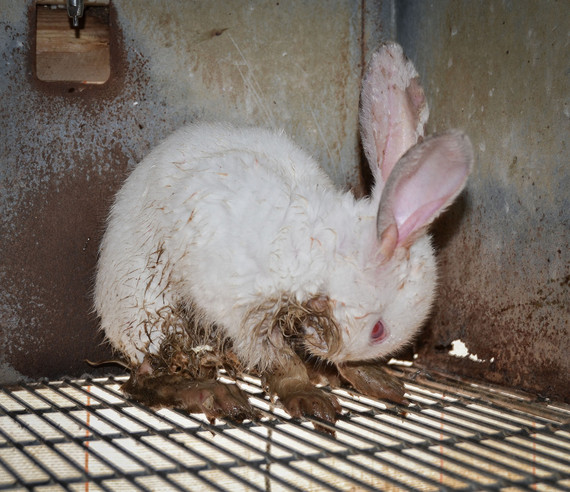
Photo: Jo-Anne McArthur, WeAnimals.org A sick and injured rabbit on a Spanish farm.
Late in 2014 a groundbreaking expose had the fashion industry reeling, with major brands under fire. Over 70 rabbit farms investigated in Spain revealed abhorrent conditions considered business-as-usual: farm workers bashing sick rabbits to death, crippled, diseased and severely wounded rabbits left to suffer in small, crowded cages with metal bars for floors with no medical treatment, and rabbits being bludgeoned to death or slammed to the floor before being skinned. Similar exposés shed light on angora and wool. Two investigations released in February 2015 exposed the horrifying dog leather industry in China, the global leader in leather production, and typical practices on mink farms. The laws and regulations established by the European Union are merely guidelines that are not enforceable. Even the industry's most stringent and much-touted Origin Assured certification has fallen short of even the most basic ethical standards when investigations surfaced in recent years of farms in Sweden, Finland, Norway, Denmark, as well as trapping the USA. In November 2014, a fur farmer in Canada was charged with six counts of animal cruelty - the same farmer convicted on 32 counts of neglect in 1996. The award winning documentary "The Ghosts in Our Machine" takes us behind the scenes at fur farms in Europe and revealed similar conditions in a series of haunting images. And as Forbes reported on in 2012, China is the largest fur-producing and animal farming nation in the world and has virtually no animal welfare regulations at all. The evidence is overwhelming.
Investigators have little to gain financially from sharing these exposés. On the other hand, fur, a $40 Billion-and-growing industry, has a lot of money to lose, which is why they must cast doubt on the legitimacy of all investigation materials and pretend their only opposition is PETA. They also love to play victim. Garnsworthy says " [I]find myself looking over my shoulder for flying buckets of red paint regularly". This is a favorite trope used in the self-victimization of fur-wearers, yet red paint hasn't really been flung since the 90s. On the other hand, fur retailers in New York City were arrested for allegedly flinging a far more dangerous liquid. A toxic mixture of bleach and ammonia was dropped onto a group of picketing citizens and pedestrians in New York City just weeks ago. On top of that, the industry is notorious for poor regulations, leading stores like Barney's, Century 21 and Neiman Marcus to sell cat and dog fur labeled as faux. The proble is so pervasive that on Dec. 18, 2010 President Obama signed H.R. 2480, the Truth in Fur Labeling Act.
Garnsworthy feigns concern for the ecological impacts of synthetic fur saying, "fur advocates claim faux varieties are terrible for the environment". She ignores the intensive, chemical processing that furs must go through to prevent them from decomposing. An investigation in Italy in December, 2014 found carcinogenic toxins like hexavalent chrome and formaldehyde present in clothing intended for babies and toddlers. England, Denmark, Holland, Finland and Italy have ruled that any advertising claiming fur as environmentally friendly is false and misleading. The Suzuki Foundation, The Humane Society of the United States, CE Delft, and Acadia University have all documented the environmental impacts fur farming from energy use to waste runoff and toxic algae blooms. If Garnsworthy never wore synthetics, I might understand why she'd attempt to make this argument, but she's not concerned with a polyester shirt, the chemicals used in processing and dyeing fur, or even the fact that many fur garments, like Canada Goose, are in fact lined with poly, nylon and treated with synthetic water repellant. It's only synthetic fur she takes issue with, a subversion of that which is supposedly "real" and "authentic."
There's a scene in Ghostbuster's II I like to show in class that's a good laugh, and good ice-breaker. In the scene a fur-clad woman unknowingly steps into some supernatural pink ooze and her fur coat leaps back to life to seek vengeance. We laugh because this is a ridiculous scenario, but beneath the comedy is a haunting truth: animals do desperately, loudly and futilely fight for their lives. Like us, animals have a will to live, a consciousness and a perspective. The 2012 Cambridge Declaration on Consciousness was publicly proclaimed by a prestigious group of neuroscientists, yet fur, a powerful status symbol stemming from King Edward III's sumptuary laws of the middle ages, is marketed by an industry that operates on ideas about Animals that may as well be from the Middle Ages.
In most fashion discussions about fur, the argument is reduced to a personal-choice issue that sounds something like this: "I respect that you don't wear fur, and you should respect that I do". What's missing -- what's always missing -- is the most crucial perspectives of all: the animals' whose very lives and bodies are stake. They are continually ignored and invalidated. When the animal perspectives are considered, as science has proven they should be, the "choice" whether or not to wear fur becomes startlingly clear. And choosing to avoid animal fur does not mean choosing ugliness.
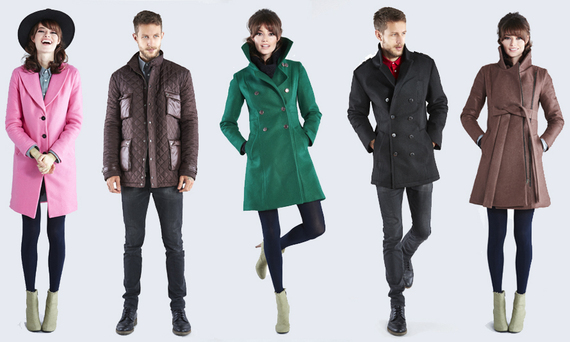
Vaute Couture.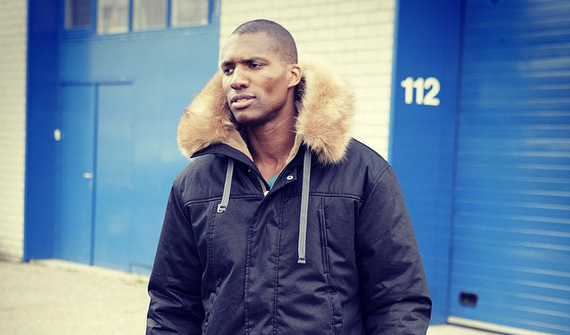
Hoodlamb Parka.
Ethics and aesthetics are not mutually exclusive, but it suits the fur industry to perpetuate the idea that ethical fashion is inherently uglier than "unethical" fashion. In this sense, fur is framed as a naughty treat -- heightening it's desirability. It is instead, economics that stands at odds with ethics, because it is the desire for wealth and the ingrained and potent fur-symbol of wealth, sex and power that drives the fur industry -- not design or even function. We already have impressive, hi-tech, ethically-made, winter weather brands like VAUTE and Hoodlamb. If young designers and students were presented with comparable incentives to use visionary materials, we would see far more of it on the runways in the same way we see fur. Currently both Stella McCartney and Bruno Pieters offer scholarships with this in mind, and both Nike and NASA sponsor green chemistry challenges to bring low-cost, low-impact and biodegradable synthetics to market, but so much more opportunity for innovation is needed. Earlier this year, researchers at Duke University grew contracting muscle in the laboratory. This June, Pembient will release lab-grown rhino horn and later, lab grown ivory. It is only a matter of time before we are growing fur, wool and feathers without the animals attached, and design students are a worthy investment in this exciting future. That is truly good design.
